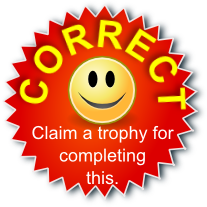When you have found a shape, click its button below:
Well done. Shape found!
Now rearrange the pieces to form a different shape.

Your answer is not correct. Try again.
You must drag all of the pieces onto the grid.
![]()





When you have found a shape, click its button below:
Well done. Shape found!
Now rearrange the pieces to form a different shape.

Your answer is not correct. Try again.
You must drag all of the pieces onto the grid.
![]()
There are solutions to each level of this puzzle showing the completed polygons but they are only available to those who have a Transum Subscription.
A Transum subscription also gives you access to the 'Class Admin' student management system, downloadable worksheets, many more teaching resources and opens up ad-free access to the Transum website for you and your pupils.
Your challenge is to drag the pieces of the puzzle onto the grid to form polygons. To complete level 1 there is just one polygon to make, level two has two polygons and so on.
Each time you load this page a different puzzle is loaded at random. There are 18 different polygons in up to four different orientations multiplied by 9! ways of slicing up the polygon on to the pieces. It is highly unlikely that you will ever get the same level 5 puzzle more than once.
When you have made a polygon, click on the button so that the computer can check if you are right. You will then need to rearrange the pieces of the puzzle (level 2 and above) to make the next polygon. When all polygons for that level have been found you can claim your Transum Trophy.
You should place all of the pieces on the grid even if they are not required to produce the polygon. If you try to place two pieces on the same grid square the second piece will float away!
For the purposes of this exercise a rectangle is not a square (even though mathematically it could be). The rectangle that you need to make does not have all of its sides the same length. The same rule applies to other polygons so an isosceles triangle is not an eqilateral triangle etc.
The list of polygons used in this activity are a square, an equilateral triangle, a rectangle, a parallelogram, a rhombus, a regular pentagon, a regular hexagon, a regular octagon, a trapezium, a right-angled triangle, an isosceles triangle, a regular decagon, a regular nonagon, a kite, a regular heptagon, an irregular pentagon, an irregular hexagon and an irregular quadrilateral.
Do you have any comments? It is always useful to receive feedback and helps make this free resource even more useful for those learning Mathematics anywhere in the world. Click here to enter your comments.